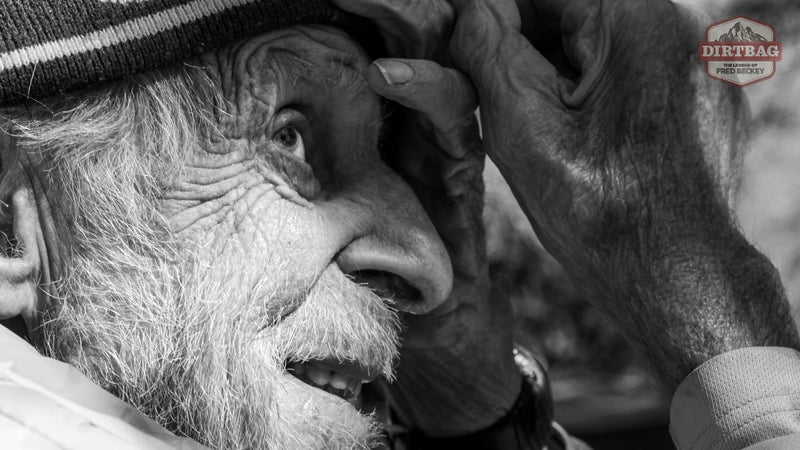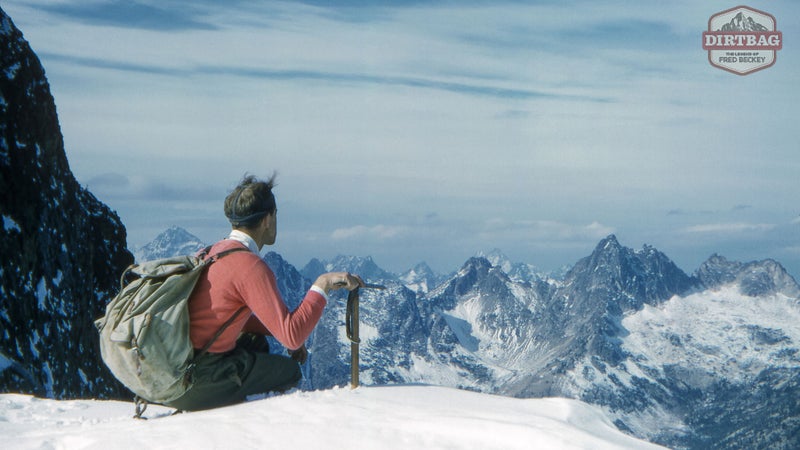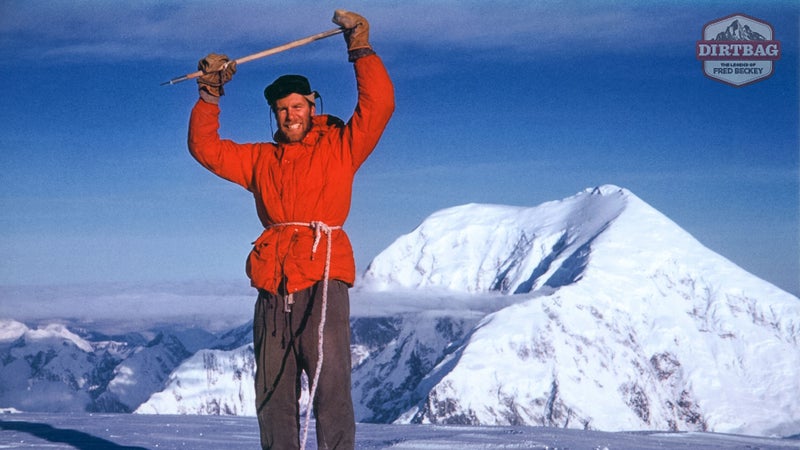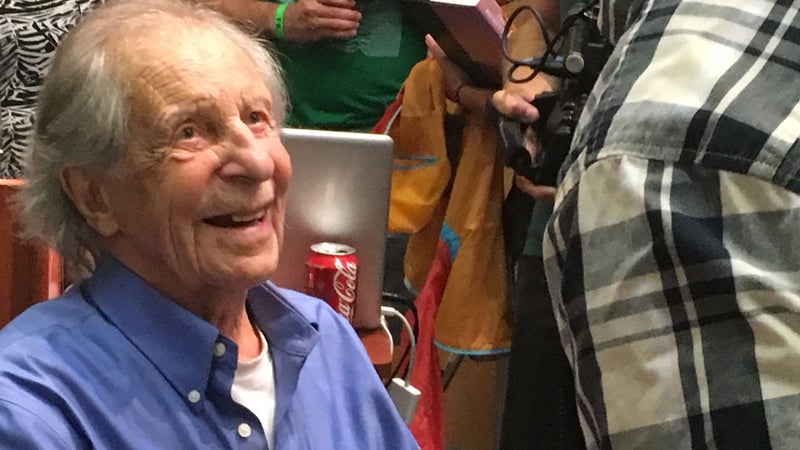When climbers in the North Cascades complete what they believe to be a new route, they write to Fred Beckey. They write because they think they’ve done something that Beckey did over and over and over in his legendary life of climbing. They think they did it first, and they want recognition from the man with perhaps more first ascents to his name than any other in history; they want to be known by the man who is known for his encyclopedic knowledge of the sport.
��
Early in his climbing career—in the 1940s, a 20-something-year-old barely out of Boy Scouts—Fred Beckey began to search out peaks that the Mountaineers Club in his hometown of Seattle had marked unclimbable: spikes and blades of rock that members of the organization determined were unassailable by man. Then he'd climb them. He made almost a cruel sport out of it, taking the sober prescriptions of experts and whipping them with climbing rope.��
Initially, many members of the Mountaineers resented Beckey. But such was his ability that, soon enough, the rift was gone for the simple reason that he had redefined what a mountaineer was.��
“His climb on Midway, in 1948, was said to be the first modern rock climb in Washington,” says Matt Perkins, a climber and friend of Beckey’s, referring to a now well-known climb in the Central Cascades. “Rope, belay, intermediate protection. What we’d call fifth class climbing today.”��
Whispers circulated that he was reckless. He was burning hot, and he was bound to overheat.
In 1973, the Mountaineers—hatchets by then well buried—published Beckey's first North Cascades Climbing guide. Today, the guide—which is published in three��volumes—has seen three editions and seven press runs. In the age of SummitPost and PeakBagger, the guides are still considered a necessary piece of gear for expeditions in the rugged Pacific Northwest country, a veritable canon of climbing routes in that splintered part of world. Countless climbers have schlepped the books to base camps, seeking an edge in the game that Fred Beckey all but invented.
The book, simply titled , was his formal answer to the question that came to every climber who gaped in awe of his accomplishments: How the hell did he do that?
When climbers today write him and brief him on their routes, there’s little doubt that Beckey will more or less be able to picture it vividly. Beckey will turn the route over in his head, running it through the most complete encyclopedia of American mountaineering in existence today—his brain. He may then dismiss the route as nothing special. Then again—and this is why they write—he may decide it’s a route worth including in the next edition of Mountaineering in the North Cascades.
“That’s a big part of what he’s doing now. Going through other climber’s routes,” says Perkins. “Climbers still report their routes to Fred, because Fred’s book remains the book of record in the North Cascades.”

Beckey is 93 now. His hearing is shot but his brain is sharp. He owns a modest two-story home in North Seattle, and he’s still singularly obsessed with the mountains.��
When he walks, he does so hunched over and with the aid of two aluminum walking sticks, evidence of a life lived to test the limits of the human body. Yet when he complains to me that he's only been climbing a few times in recent months, I ask dumbly for clarification: Climbing? As in: With ropes?
“O�� course with ropes! It's not climbing without ropes.”
Back in his early days, when his daring ascents were first making the papers, it was only natural that some resentment set in among other climbers. As Beckey achieved first ascent after first ascent, whispers circulated that he was reckless. He was burning hot, and he was bound to overheat.
True enough, death was close to Beckey early in his career. In 1947, Beckey was climbing the Waddington Range in British Columbia with a group of Harvard climbers when he and three others were caught in an avalanche. Beckey's hip was injured, another climber died. In 1952, on Mt. Baring in the North Cascades, he and his partners were descending at night, driven off the mountain by weather. The lead climber—a man named Dick Berge—took a wrong turn, which in that rugged country meant plunging to his death.��
Decades into his career, climbing partner Peter Schoening put the doubts surrounding Beckey this way to the in 2003: “Fred would climb these spectacular things, and there was word that Fred was unsafe and he was going to get himself killed and it would reflect poorly on climbing.”
Yet he's still here today, credited with hundreds of first ascents—though the exact number is elusive, it’s widely considered to be the most of any American climber. There is little doubt that he will not be surpassed. There's just not enough mountains left to climb for anyone to catch up.��
“There’s just no comparison with Fred,” Phil Powers, CEO of the American Alpine Club, told ���ϳԹ��� for an oral history of the man back in 2010. “I mean, it’s not one level, but ten levels of magnitude more than the second-place guy. If you travel the American West, open any guidebook, try to do any route, try to do any mountain, you’ll likely come across Fred’s name.”

His poor hearing makes conversation with him trying. But when questions get through, he’s sharp in his answers. So what about those rumors, Fred, that you were dangerous and wouldn’t last?
“I've always been a safe climber,” he says. His very existence proves that he's correct. Deep crevices are weathered into his face, and the lines are one of a man who spent most of his life either smiling or squinting up at a peak. His forehead has a divot so big a climber could probably get a toehold in it. It is not from a climbing accident but a car accident, Beckey being far less careful a motorist than mountaineer. He's lost his license on account of too many tickets, which public records show include driving without a seatbelt and driving 50 miles-an-hour in 75-mile-hour traffic while talking on a cellphone. And that's just what's on file at courthouse in downtown Seattle. According to his friend Megan Bond, you'd have to search a century of records across Idaho, Utah, Arizona, California, and Canada to truly grasp Beckey's inability to comply with traffic regulations.
At the peak of his career, in a typical year he’d drive his pink and black Ford Thunderbird on a months-long circuit of mountains, Arizona in the winter, Alaska in the summer, as many months as his finances would allow him. He kept a running list of climbing partners, and would pester them to come out with him. No one was able to climb as much as Beckey did—they had jobs, family—so when one partner dropped off, he'd call another. After a while, it became a seal of pride for climbers to get a call from the rock-obsessed Beckey. He has yet to give the practice up.
“He's constantly recruiting people to take him out. That's one of the motivations to meet the climbers. Fred will be asking if he wants to take him climbing,” Perkins says. If worst comes to worst, he'll even swallow his pride and go to a climbing gym.��

“He's not a fan of indoor gyms,” says Bond. “But he'll go if he's wanting something to do.”
Perkins, who still has dinner with Beckey on an almost weekly basis, says Beckey reached out to him in 2002, just shy of Beckey's 80th birthday, asking Perkins to join him on a trip to the Monarch Ice Fields in the Coastal Range of British Columbia. The goal was to summit Cerberus Mountain, accessible only from a long traverse across the remote expanse of ice. Beckey arranged the helicopter flight and skied in four miles to the base camp.��
“Personal questions—he doesn't see the value in that,” Reid says. “Ask him about a route, and he can talk forever.”
Lore has is that Beckey can be a taciturn climbing partner, petty and bitter to those who stand in the way of his plans. Perkins says there's truth to that, but that you see another side of him when you're on the mountain together.��
When the day of the Cerebrus climb came, Beckey was physically unable to do it, Perkins says; but when Perkins and another climber “staggered” back into camp at midnight, Beckey insisted on cooking them all dinner.
“He is self-serving in all the ways you read about, but he did want to get up and cook us dinner after climbing Cerberus,” Perkins says.
Bond, who also met Beckey later in his life, says many people only see Fred as the man he once was, and ignore the fact that, like all humans, he's changed over the years.��
“The way some people think about him now is predicated on who he was 50 years ago, 70 years ago,” she says.
A lot of what Bond sees as a misunderstanding of Beckey grows out of the “dirtbag” label that has become synonymous with do-it-on-the-cheap climbing lifestyle Beckey pioneered. While it's true that Beckey would drive around with a McDonald's coffee cup so he could nick free refills during road trips, his dirtbag reputation has a way of distracting from his substantial intellectual feats. His climbing guides include deep research into the history of the mountains he's climbing; he's also published a memoir and a comprehensive history of human exploration of the Cascade Mountains.
“You hear about the dirtbag stuff, but you never hear about him going back to Washington, D.C., to look up old mining claims at the U.S. Geological Survey,” says Perkins.��
“He's very upset at that word [dirtbag],” Bond says. “He's accomplished more than most people, he's done more research that most college professors. Needless to say his writings are up there with John Muir.” (That might be a matter of taste, but there is no denying that Beckey is a strong writer who doesn't suffer from the stunted or overwrought prose of many adventure authors).
One assumption about Beckey that is true, though, is that when it comes to his day-to-day life, it's nearly all about climbing, Bond says. He likes college football��and will go to a bar to watch Pac-12 games; he takes a few trips a week to Safeway to replenish a supply of orange juice and donuts. But beyond that, it's rock.
In old age, “most people dial back,” says Bond. “He's dialed in. He's more tenacious.”
This near-inhuman singular obsession with climbing has long created a sense of mystery around Beckey—whether or not that mystery is real or projected.
Dave O'Leske has spent the last 11 years working with Beckey on a documentary about his life. When they began, Beckey was still driving the climbing circuit he’d refined over the decades, hitting the Southwest in the early spring and following the weather north into Washington state and British Columbia. A climber himself, O’Leske was fascinated watching the then-82-year-old work the routes. But he also was intrigued by Beckey’s life off the rock walls; he wanted to know who Fred actually was. He knew all about his mountaineering and a little bit about his roguish reputation as a lady's man. But none of that seemed to speak to the man himself. A life can't consist entirely of climbing routes, can it?
“I always looked up to Fred, and was intrigued by his mystery,” O'Leske told me in Seattle recently, where he was launching a Kickstarter campaign for the documentary, .��(Despite his disdain for the word, Beckey is fully on board with the documentary.) “I just couldn't believe there wasn't anything else there.”��
But when O'Leske would ask Beckey about more personal details of his life, Beckey would demure. “No one cares about that stuff,” he'd say. “Who would care about that?”��
It’s not that he's protective of anything: as part of the documentary, he turned over his journals, which contain lots of discourse on climbing, but also some personal details on his life off the mountain—specifically, notes on women met along the way. Jason Reid, a producer on “Dirtbag,” said Beckey is aware that the documentary seeks to explore the personal side of his life. He doesn't object; he just doesn't understand why.
“Personal questions—he doesn't see the value in that,” Reid says. “Ask him about a route, and he can talk forever.”

At the Kickstarter event, Beckey took the stage before 500 fans who seem ready to clutch to every word like it was do-or-die overhang. Other men who'd lived long great lives, provided an audience of devotees, would likely talk about themselves in such a setting. Beckey, though, talked about Gengis Khan and Hannibal of Carthage and Horace Benedicte de Saussure—men whose exploits in the mountains he felt were more important to talk about than his own.
After this brief history of mountaineering, Beckey led a slideshow through some of his various expeditions. Watching him instantly recall the circumstances and outcomes of dozens of climbs by a simple glance at a rock face reminds one of a grandmother looking through a photo album of grandchildren. This one went to Harvard. She lives in Dallas…
The mountains, after all, were the closest thing Beckey had to family. He never married, never had children.��
One of the 500 people in the crowd is a woman named Vasiliki Dwyer, whose cosmopolitan outfit and lovely perfume draws a stark contrast to the REI aesthetic that dominates the room. Dwyer met Beckey skiing one day in 1952 on Stevens Pass outside Seattle. She lost a ski and Beckey, working on ski patrol, retrieved it. Beckey managed to convert that small act of chivalry into a brief courtship. They skied and hiked and played tennis together (Fred was lousy at tennis.)
“I knew the other side of Fred,” Dwyer says. “Fred also was very well-read, interested in good literature.”��
Did he not want people to see that side of him? “No,” she says, “He just never thought that his climbing friends were interested.”
How serious Beckey's feelings for Dwyer were is a point of dispute. Timothy Egan included a now-famous profile of Beckey in his 1990 book .��In the piece, Egan makes Dwyer out to be the great love that got away; Bond insists things were far more casual. Regardless, Dwyer says today, “there was never any question of marriage.”
“What would he do with a baby?” she asks, a look of wonderment in her face as she asked it. “I can't even imagine. He couldn't be married. How could he be married? He's married to the mountains.”

